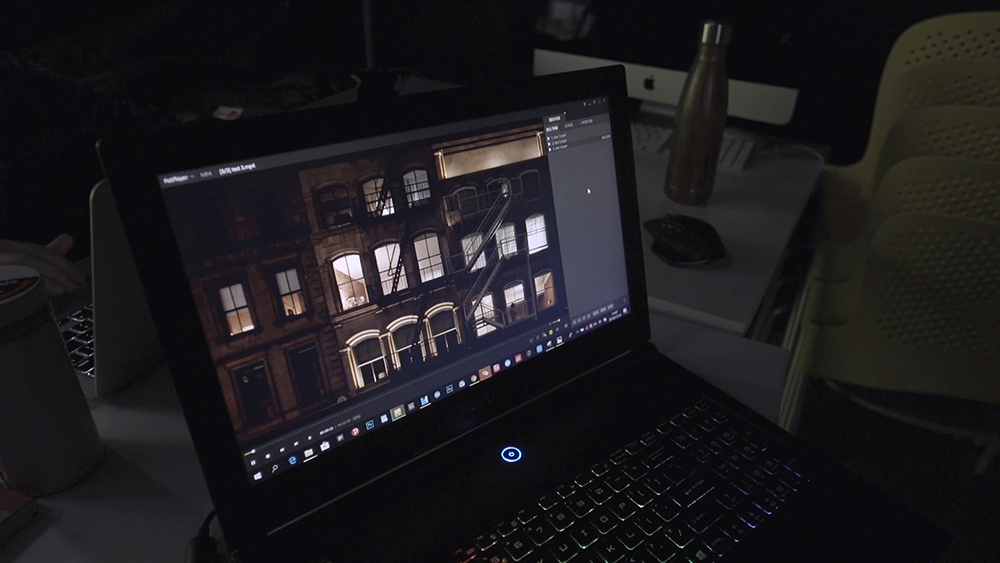
A new performance of The Little Match Girl in Baltimore breathes entirely new life into the Hans Christian Andersen story. Baltimore Choral Arts Society (BCAS) director Anthony Blake Clark combines David Lang’s Pulitzer Prize-winning composition The Little Match Girl Passion with Johann Sebastian Bach’s St. Matthew Passion oratorio, which inspired Lang’s piece, to create a whole new production, weaving the story of a young girl living on the streets with the story of Christ’s death. Interspersing both pieces provides context, as pivotal moments of the Bach piece are interspersed throughout the predominately a cappella performance.
But the production, which will be held at Falvey Hall in the Brown Center on February 10, takes this innovation one step further. BCAS partnered with MICA students and faculty to enhance the musical performance with artistic elements that engage nearly all five senses. Billed as an immersive, multi-sensory performance, the show features video projects behind the chorus (comprised of about 30 vocalists).

Each video depicts illustrations and photographs of homelessness and other themes in the story, as well as lyrics to the pieces—some interpreted more broadly rather than straight subtitles. St. Matthew Passion is sung in German and even Lang’s piece in English can be difficult to decipher at times, as the lyrics are often sung abstractly, sometimes extremely long and drawn out, other times extremely staccato. The images and words not only make the story easier to follow but are visually intriguing, essentially act as a multimedia set.
A beautiful moment comes when the chorus begins to strike matches and hold the tiny flames up in the air. The sound of friction and sparks, the image of burning flames and smoke, and the scent of sulphur aids in placing the viewer into the world of the little match girl. And she herself is onstage as well, subtly acting the storyline silently—trying to sell matches on the street—to provide a visual while not detracting from the chorus and moving images overhead. MICA’s interactive arts students had partnered with other groups in the past, including the Towson University theater department and an annual collaboration with Peabody Institute, but The Little Match Girl marks their first collaboration with BCAS.

MICA and BCAS are just down the street from each other so, when Clark wanted to try something new stylistically, he approached James Rouvelle, chair of the Interactive Arts Department at MICA, who got onboard right away.
“I was really interested in it partly because I have a background in musical performance,” Rouvelle says. “I think it was a good experience for everyone involved.”
The cross-pollination concert took months of work from both parties. Clark came to the media performance class at MICA several times during the process. And while it’s unusual for an instructor to participate in the creative process alongside the students, Rouvelle wanted to show his students what a professional experience felt like.
“I encouraged the students to take a risk. We’ve been hired to do something,” he says. “They took a lot of risks. Our hearts are starting to beat faster and faster, the closer we get to the show.”

The music in and of itself is enthralling, chilling at times. At one point, the chorus walks offstage and into the aisles, lining the length of the auditorium to sing a moving piece that fills the space with gorgeous textures in surround-sound. Another time, Canadian composer Stephen Chatman’s “How Sweet and Fair” features a clarinet amid the audience, representing a solo voice in the story. The piece revolves around a flower, symbolizing the fact that we all fade away, and sonically serves as a palate cleanser.
There are a few other surprises that will engage the audience’s five senses, but we don’t want to spoil the show by revealing everything here.

Choosing to work with The Little Match Girl story—both Lang’s and Bach’s pieces—and to make it engaging and provide as much context was very intentional on the part of Clark. The story highlights homeless, poverty, and human suffering, themes he felt important to bring to the forefront through art, issues that still plague our country and certainly Baltimore City. Stories of neglecting the poor and desolate are in the Bible, Hans Christian Andersen’s story, and Lang’s piece, all completely relevant today.
“We have so much work to do in Baltimore particularly. Even the simple act of empathy can help,” Clark says. “I think we put blinders on because things are overwhelming to us. But art has this ability to open us up and break down barriers, so we can become more aware of each other’s lives.”

